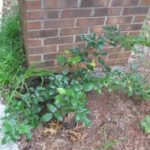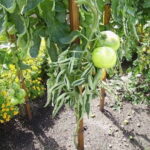A Garden Guide To Growing Tomatoes
Tomatoes are one of the most common plants for the backyard vegetable garden. Popular due to the versatility of their fruit and the ease with which they grow in most gardens, just a few tomato plants can yield a large and delicious crop with proper care and nourishment.
Choosing Varieties
When selecting varieties to plant, be mindful of the two basic types of tomato plants. Determinant varieties stop growing new vines when flowering begins, leading to a large, single crop. Indeterminant varieties continue to add new growth throughout the growing season, producing fruit from mid-summer until the first frost.
Tomatoes are prone to a number of common garden maladies, including verticillium wilt, fusarium wilt and nematodes, but popular disease resistant hybrid varieties are available to avert these potential problems. Disease resistances should be indicated on the seed packet or plant tag.
Tomatoes are also classified by their harvest time, as early, mid or late season, as well as by the type of fruit they produce. Planting a mix of tomato types can extend your harvest season and provide the perfect tomato for every use. Slicing tomatoes tend to be large and meaty, with pockets of seeds. Sauce tomatoes are more solid and fleshy, with fewer seeds. Cherry and grape varieties produce small fruit perfect for snacking or salads.
Planting
Tomatoes are warm weather plants, and must be started indoors in most U.S. climates. Starting tomatoes from seed requires carefully controlled growing conditions to ensure strong, healthy seedlings, but doing so can allow the home gardener to select from a much wider selection of varieties than are available to purchase as seedlings.
Tomato seedlings take 6 to 8 weeks to reach transplant size, and should not be moved to the garden until 2 weeks after the last frost date for the area. Sow seeds ¼” deep in a high quality seed starting mixture, and maintain temperatures between 65 and 80 degrees for proper germination and growth.
When choosing nursery grown seedlings, look for plants with straight, solid stems about the thickness of a pencil. Seedlings should have 4 to 6 young leaves, but no blossoms or fruit.
Tomatoes are easy to plant, because they are not prone to transplant shock. Like most fruits and vegetables, they need full sun, so be sure to choose a garden location that gets at least 8 hours of sun each day. They will develop roots from the stem, so if your seedlings are a bit tall and spindly, simply plant them so that the first set of leaves are near the soil surface.
Stake or cage seedlings for support as soon as they are planted in the garden, to avoid disturbing established root systems as the plants grow larger. Staked plants should be set at 2′ intervals, with 3′ to 4′ between rows. Caged plants need more room; plant 3′ apart and allow 5′ between rows for caged tomatoes.
Pruning and Care
Tomato vines need support to grow and carry the weight of abundant leaves and fruit. Cages or stakes provide the framework for this support, but proper pruning is necessary to train plants to best utilize the support method you choose. Staked plants should be trimmed back to just one or two thick, central stems, which should then be tied loosely to the stake periodically. Caged plants need less pruning. Simply remove shoots that branch off of the main stem below the first support bar of the cage and allow the plant to vine naturally over the support structure.
Tomatoes require an ample supply of nutrients in the soil and plenty of water to ward off blossom end rot, a problem characterized by dark spots that develop on the bottom end of the fruit. Adding organic matter to the soil, top dressing around the plant’s stem with crushed egg shells to provide added calcium, and watering regularly can prevent or correct this deficiency.
Spread mulch around tomato plants to keep ripening fruit off of the ground and prevent rot. Clean straw or black plastic mulch is best for unstaked plants, because vines are more likely to extend over the cages and down to ground level. Mulching can also help to retain moisture in the soil and has the added advantage of keeping weeds down.
Harvest
Tomatoes are among the easiest crops to harvest because determining when they are ripe is so straightforward. Simply wait until the fruit turn red, pick, and enjoy. If there are still fruit on the vine when the growing season is coming to an end, tomatoes can be picked green before the first frost and allowed to ripen indoors on a sunny windowsill or counter.
Reference:
- This article originally appeared at Garden & Hearth, where you can find more garden guides and a thriving gardening community. www.gardenandhearth.com






